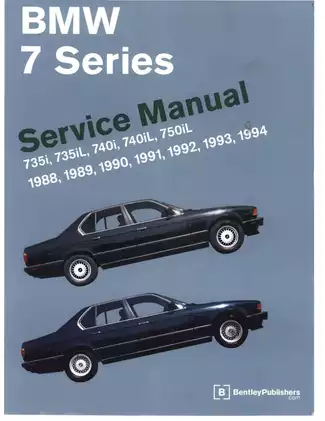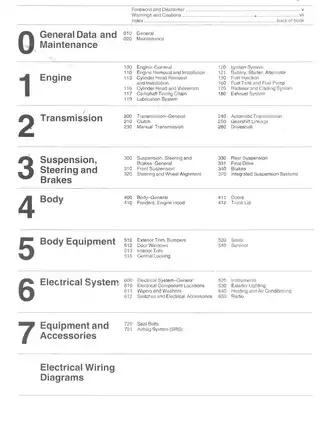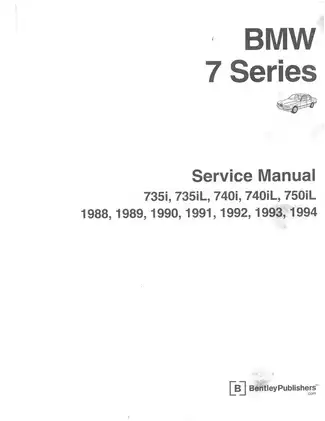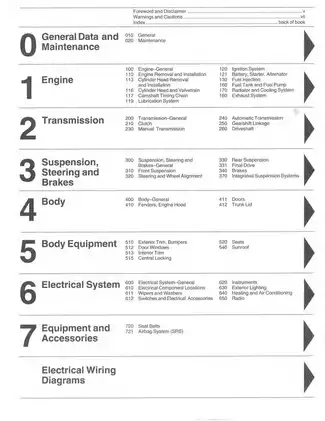Factory Service & Repair Guide: BMW 735i, 735iL, 740i, 740iL, 750iL (1988-1994)
Product Gallery

Sample pages from the Factory Service & Repair Guide: BMW 735i, 735iL, 740i, 740iL, 750iL (1988-1994) manual




Purchase Information
BMW 7 Series Service Manual (1988-1994) for DIY Maintenance and Repair - Technical Specifications
- File Size:
- 61.04 MB
- File Type:
- Language:
- English
- Printable:
- Yes
- Estimated Download Time:
- 1.25 Minutes
- Delivery Format:
- Digital (PDF) - Instant Access
- Category:
- Car
- Brand:
- BMW
BMW Models and Parts Covered in this Car Manual
- 735i (1988-1994)
- 735iL (1988-1994)
- 740i (1988-1994)
- 740iL (1988-1994)
- 750iL (1988-1994)
Complete Manual Information
BMW 7 Series Service Manual (1988-1994)
The BMW 7 Series Service Manual is an essential resource for both professional technicians and DIY enthusiasts who own a BMW 735i, 735iL, 740i, 740iL, or 750iL from the years 1988 to 1994. This comprehensive guide provides detailed service information, technical specifications, and wiring diagrams which are crucial for maintaining and repairing your vehicle.
Key Features
- Routine Maintenance Procedures: Comprehensive guidelines that cover everything from brake fluid changes to resetting the service indicator, ensuring that you have the knowledge to keep your BMW in top condition.
- Engine Service and Repair: Step-by-step instructions on performing engine repairs, including valve adjustments for the 3.5L and 4.0L engines, valve clearance checks, and timing chain setup for the V12 models.
- Troubleshooting: Effective techniques for diagnosing driveability problems across various engine management systems (DME), along with troubleshooting methods for ABS and traction control systems.
- Electrical Systems: Detailed wiring diagrams and electrical component locations that will help you understand and repair your car’s electrical systems.
What's Inside
The manual is structured into key sections including:
- General Data and Maintenance (010)
- Engine (100-199)
- Transmission (200-299)
- Suspension, Steering and Brakes (300-399)
- Body (400-499)
- Electrical System & Wiring Diagrams (600-699)
Furthermore, each major section is subdivided into specific repair groups with clear instructions and illustrations that make complex repairs manageable.
This manual is designed to empower BMW owners by providing them with the tools and knowledge to perform their own repairs and maintenance. With clear language, illustrated guidance, and practical advice, it is an invaluable addition to any garage
Download Instructions for BMW Car Manual
Frequently Asked Questions - BMW Car Manual
What does this BMW manual cover?
This comprehensive service manual covers detailed repair procedures, maintenance schedules, troubleshooting guides, and technical specifications for Factory Service & Repair Guide: BMW 735i, 735iL, 740i, 740iL, 750iL (1988-1994). It includes information for the following models: - 735i (1988-1994) - 735iL (1988-1994) - 740i (1988-1994) - 740iL (1988-1994) - 750iL (1988-1994).
Is this manual suitable for beginners?
Yes, this BMW manual is designed for both professional technicians and DIY enthusiasts. It includes step-by-step procedures with clear illustrations and safety guidelines for Car maintenance and repair.
What file format will I receive?
You will receive this manual as a PDF file (61.04 MB), which is compatible with all devices. The manual is fully searchable and printable for your convenience.
How quickly can I access the manual after purchase?
You'll receive instant access to your BMW Car manual immediately after payment completion. The download link is valid for 3 days, with lifetime re-download guarantee.
Does this manual include wiring diagrams?
Yes, this automotive service manual typically includes electrical wiring diagrams, component locations, and diagnostic procedures specific to your BMW vehicle model.
Can I print specific sections of the manual?
Absolutely! This digital manual allows you to print any section you need, from individual pages to complete chapters, making it perfect for workshop use.
Customer Reviews and Feedback
Read what our customers say about this BMW Car manual and share your own experience.
Add Comment
This policy contains information about your privacy. By posting, you are declaring that you understand this policy:
- Your name, rating, website address, town, country, state and comment will be publicly displayed if entered.
- Aside from the data entered into these form fields, other stored data about your comment will include:
- Your IP address (not displayed)
- The time/date of your submission (displayed)
- Your email address will not be shared. It is collected for only two reasons:
- Administrative purposes, should a need to contact you arise.
- To inform you of new comments, should you subscribe to receive notifications.
- A cookie may be set on your computer. This is used to remember your inputs. It will expire by itself.
This policy is subject to change at any time and without notice.
These terms and conditions contain rules about posting comments. By submitting a comment, you are declaring that you agree with these rules:
- Although the administrator will attempt to moderate comments, it is impossible for every comment to have been moderated at any given time.
- You acknowledge that all comments express the views and opinions of the original author and not those of the administrator.
- You agree not to post any material which is knowingly false, obscene, hateful, threatening, harassing or invasive of a person's privacy.
- The administrator has the right to edit, move or remove any comment for any reason and without notice.
Failure to comply with these rules may result in being banned from submitting further comments.
These terms and conditions are subject to change at any time and without notice.
Comments (3)